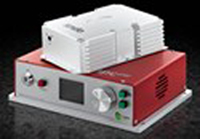Raman Spectroscopy Based Sensing Platform For An Indirect Marker Of Blood Glucose
Dr. Rishikesh Pandey of G.R. Harrison Spectroscopy Laboratory, Massachusetts Institute of Technology, USA, is at the forefront of Biomedical and Clinical applications of Raman spectroscopy

His focus is on how to develop and deploy biophotonic techniques that bridge physical chemistry, clinical diagnosis and Raman spectroscopy. Specifically, he works to employ vibrational spectroscopic and imaging techniques to obtain biochemical signatures that can reveal latent information on pathological conditions.
Non-enzymatic glycation is a process by which glucose is chemically bound to proteins, the concentration of these glycated proteins provides the metric for blood glucose concentration. Unlike normal blood testing, which gives a snapshot of blood glucose regulation at a single moment in time, these biomarkers reveal retrospective value of blood glucose, for instance, HbA1c -glycated haemoglobin- provides integrated glucose value in the blood stream for preceding three months. The secondary diabetic complications correlate more strongly with the elevated concentration of HbA1c than the routinely used measurement of fasting glucose and HbA1c measurement has gained traction is recent years for the pre-screening of diabetics.
Currently, Dr. Pandey is developing a resonance Raman spectroscopy-based approach for accurate, objective and reagent-free sensing of HbA1c for point-of-care settings. In his proof-of-principle experiment, he uses Laser Quantum’s opus 532. He has promising experimental results and the manuscript is currently under preparation.
Dr. Pandey said ‘the very small footprint of the opus allows integration into our experimental set-up with ease. We’ve been using the opus 532 for 1.5 years with no problems and we are very happy that we bought it. In terms of my research, the stability of the laser enables repeatable, precise results and we can use the opus remotely which is very important for some of my experiments. As our work involves laser and multiple detectors communicating, the LQ software enable this to be done easily and it is extremely valuable to us.’
Dr. Pandey plans to conduct further experiments in the longer term with glycemic markers and apply this research to other biomarkers. He can envisage substantive advantages of Raman spectroscopy in terms of molecular specificity and its ability to easily couple to a fiber-probe that will enable its ready translation to a point-of-care setting. Dr. Pandey also intends to extend his research to other emerging domains that address real clinical questions and have translational potential with a ‘from bench to bedside’ aim to improve the quality of human life.
For more information on Dr. Rishikesh Pandey, please visit his website: http://www.rishikeshpandey.in/
CONTACT
Andy Wells
Laser Quantum UK Ltd
sales@laserquantum.com
www.laserquantum.com
+44 161 975 5300
Saturday 19 March 2016 / file under Technology | Pharmaceuticals | Medical | Chemical | Biotechnology



